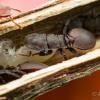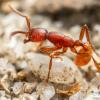So, I know the differences between these 2 but I recall a few years ago having a Stigmatomma pallipes colony and I also found another one that was physically smaller than Stigmatomma pallipes. I'm talking about like 2mm smaller in comparison. I tried to combine them but they didn't accept these smaller ones and I took them out. This is curious to me cause I've always been able to combine colonies with no problem. I ended up keeping them for a bit but they all died. I wish I had kept samples cause looking back it could've very well been Stigmatomma trigonignathum! Or some new species. I don't think I've EVER seen another colony since and all the Stigmatomma pallipes queens I've seen were the same size! But these were, again, 2mm smaller, also, more of a pale orange color. I'm in doubt somewhat cause Stigmatomma trigonignathum is the Rarest ant in North America, even giving it the name the Bigfoot ant. It's only been seen 2 times and both in NC. (And obviously, I'm in Virginia so there's more doubt there as well). I'd like to see what you guys think.
- Formiculture.com
- Forums
- Gallery
- Members
- Member Map
- Chat














